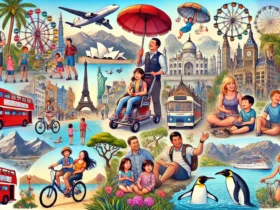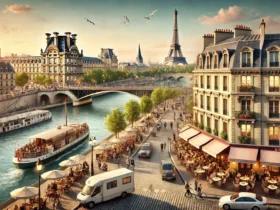Italy, with its rich history, stunning landscapes, and vibrant culture, is a dream destination for travelers. Each city offers its unique charm and attractions. Here’s a guide to the best cities to visit in Italy, providing a blend of historical sites, artistic treasures, and delicious cuisine.
1. Rome
Rome, the capital city, is a must-visit destination. Known as the Eternal City, it offers a wealth of ancient history, including the Colosseum, Roman Forum, and Pantheon. Vatican City, home to St. Peter’s Basilica and the Sistine Chapel, is also a major highlight. Stroll through picturesque piazzas, enjoy authentic Italian gelato, and marvel at Renaissance art and architecture.
2. Florence
Florence is the birthplace of the Renaissance and a treasure trove of art and culture. Visit the Uffizi Gallery to see works by Botticelli and Michelangelo, and don’t miss the iconic Duomo with its stunning dome. Stroll along the Ponte Vecchio, explore the charming streets, and enjoy Tuscan cuisine in local trattorias.
3. Venice
Venice is a city like no other, with its network of canals and historic architecture. Take a gondola ride through the canals, visit St. Mark’s Basilica, and explore the Doge’s Palace. Wander through the narrow streets and discover hidden gems around every corner. The annual Carnival of Venice in February or early March is a vibrant and colorful event worth experiencing.
4. Milan
Milan is Italy’s fashion and design capital, but it also boasts significant historical and cultural attractions. Visit the stunning Milan Cathedral (Duomo di Milano), see Leonardo da Vinci’s “The Last Supper” at the Convent of Santa Maria delle Grazie, and explore the fashionable Quadrilatero della Moda district. The city is also known for its vibrant nightlife and culinary scene.
5. Naples
Naples is a city with a unique character and the birthplace of pizza. Visit the historic city center, a UNESCO World Heritage site, and explore the underground Catacombs of San Gennaro. Take a day trip to the nearby ruins of Pompeii and Herculaneum, or to the beautiful Amalfi Coast. Don’t forget to try authentic Neapolitan pizza and seafood.
6. Verona
Verona, the setting of Shakespeare’s “Romeo and Juliet,” is a city full of romance and history. Visit Juliet’s House with its famous balcony, explore the well-preserved Roman Arena, and stroll through Piazza delle Erbe. The city is also a gateway to the stunning Lake Garda, perfect for a day trip.
7. Bologna
Bologna is known for its medieval towers, extensive porticoes, and delicious cuisine. Visit the Two Towers (Le Due Torri), explore the historic University of Bologna, and enjoy the vibrant atmosphere of Piazza Maggiore. Bologna is also famous for its food, including mortadella, tagliatelle al ragù (Bolognese sauce), and tortellini.
8. Pisa
Pisa is world-renowned for its iconic Leaning Tower. The Piazza dei Miracoli, where the tower is located, also features the stunning Pisa Cathedral and Baptistery. After visiting these landmarks, explore the historic center, enjoy the riverside views along the Arno, and taste local specialties in nearby restaurants.
9. Turin
Turin, the capital of the Piedmont region, is known for its elegant architecture and rich cultural heritage. Visit the Mole Antonelliana and the National Cinema Museum, explore the Royal Palace of Turin, and stroll through Piazza Castello. Turin is also famous for its chocolate, vermouth, and proximity to the beautiful Alps.
10. Palermo
Palermo, the capital of Sicily, offers a unique blend of cultures and history. Visit the Palermo Cathedral, explore the Norman Palace and its Palatine Chapel, and wander through the bustling markets like Ballarò and Vucciria. Palermo’s cuisine is a highlight, with dishes like arancini, cannoli, and fresh seafood.
FAQs
Q: What is the best time to visit these cities in Italy?
A: The best time to visit these cities is during the spring (April to June) and fall (September to October) when the weather is mild and the crowds are smaller. Summer can be hot and crowded, especially in popular tourist destinations.
Q: How can I travel between these cities?
A: Italy has an extensive and efficient train network, making it easy to travel between cities. High-speed trains connect major cities like Rome, Florence, Venice, and Milan. Renting a car is also an option for exploring more remote areas, but be prepared for narrow streets and parking challenges in historic centers.
Q: What are some must-try foods in these cities?
A: Each city has its culinary specialties. In Rome, try pasta dishes like carbonara and cacio e pepe. Florence is known for its bistecca alla fiorentina (Florentine steak) and ribollita (Tuscan soup). Venice offers seafood risotto and cicchetti (small snacks). In Naples, don’t miss authentic Neapolitan pizza. Bologna is famous for its tagliatelle al ragù and tortellini. Try risotto in Milan, and enjoy chocolate and vermouth in Turin. In Palermo, taste arancini and cannoli.
Q: Are these cities family-friendly?
A: Yes, these cities offer a variety of family-friendly activities and attractions. Rome has many parks and historical sites that appeal to children. Florence’s art and interactive museums can be engaging for families. Venice’s canals and boat rides are fun for kids. Milan has several parks and kid-friendly museums. Naples offers historical sites and coastal attractions. Verona’s Roman Arena and Juliet’s House are interesting for families. Bologna, Pisa, Turin, and Palermo also have family-friendly attractions and activities.
Q: What should I pack for a trip to Italy?
A: Pack comfortable walking shoes, as many attractions are best explored on foot. Bring layers to accommodate varying temperatures, especially in spring and fall. Lightweight clothing is ideal for summer, and a good-quality rain jacket or umbrella is useful year-round. Don’t forget travel adapters for electronic devices.
Q: What are some off-the-beaten-path experiences in these cities?
A: In Rome, explore the Appian Way and the Catacombs. Florence offers hidden gardens like the Bardini Garden. In Venice, visit the quieter islands of Burano and Torcello. Discover the Brera district in Milan for art and culture. Naples has the underground Napoli Sotterranea. Verona’s Giardino Giusti is a peaceful escape. Bologna’s portico walk to San Luca is scenic. In Pisa, explore the lesser-known Borgo Stretto. Turin’s hilltop Basilica di Superga offers stunning views. Palermo’s Monreale Cathedral is a hidden gem.
Italy’s cities offer a rich tapestry of experiences, from historical landmarks and artistic treasures to culinary delights and vibrant festivals. Whether you’re a history buff, an art lover, a foodie, or simply looking to soak in the Italian culture, these cities have something special to offer. Plan your trip, immerse yourself in the local culture, and enjoy the best that Italy has to offer.






Leave a Reply